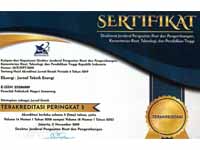Analysis of The Utilization of Solar Panels as Pump Crusters Automatically in Fish Pond Farming
DOI:
https://doi.org/10.32497/eksergi.v19i01.4246Keywords:
solar panels, Water Level Control, PumpsAbstract
Abstract”” The purpose of making this final task is to apply the solar power system as a source of electrical energy to move the water pump automatically in fish ponds. This system works automatically with the Water Level Control tool sensor (WLC), so that if the water level drops or rises then the water pump will automatically work. On this automated system use the Smart Relay SR2B121BD and the ZelioSoft 2 application.
Data retrieval carried out at 10.00 -14.00 WIB, obtained data pumps 1 and 2 for a height of 1 cm for 30 minutes and a height of 2 cm for 70 minutes. The amount of discharge the pump produces 1 and 2 ranges from 37 L/M to 45 L/M.
Pump 1 Test results obtained an average efficiency of 7.68%, with the highest efficiency of 11.03% and the lowest efficiency of 5.26%, while the average pump efficiency of 2, 7.05% with the highest efficiency of 10.66% and the lowest efficiency of 5.41%. The average efficiency of the solar panels is 11.20% with the highest efficiency of 14.60% and the lowest efficiency of 7.29%.
References
Abdelkader,M. R.dkk.(2010). A comparativeAnalysisofthe Performanceof Monocrystallineand MultiycrystallinePVCellsiSemi Arid Climate Conditions: the Case of Jordan
Erinofiardi,Imam Supardi and Redi. (2012). Use of PLC in Simulated Temperature in Room Prototypes
Iqtimal,Z.,Sara,I.D.,Shahrizal. (2018). Application of Solar Power System as a Source of Electric Power of Water Pumps
Isaac,L.F.,Sadi,S.,Personal,D.,(2015). SystemControlTemperature UsingPlcZelioSr2 B121Bd,SimulationIn PrototypeSpaceWith Temperature 29 °C - 36 °C
Iswanto, Ady. (2008). Basic Principles of Solar Cell, Staff of Research Division 102FM ITB, Bandung
Laksono,TeguhPudarMei. (2013). SystemScadaWaterLevel Control Using Wonderwareintouch Software. Semarang State University
Parastiwi,Andrianidkk. (2018). Applied Photovoltaic :Technology and Implementation. Malang : Polinema Express
Rosyadi,Nasrul Haq. (2016). AnialisisThe Potential of Wind Energy and Solar Energy Hybrid Power Plant in the Provision of Electrical Energy in Banaran Village, Yogyakarta. Muhammadiyah University of Yogyakarta
Suarda,Made.,Wirawan,IKetut Gede. (2009). Technical and Economic Studies of The Development of Electricity Power In Sanapahaan Village, Kediri District. Udayana University
Sularso,Tahara,H,. 2003. Pumps and Compressors. Jakarta
TjokGde.VisnuSemaraPutra. (2015). Analysis Of The 15 KW Solar Power Plant In Asah TebenDesaDatah Karangasem Hamlet . Bali: UniversitasUdayana.
Utari, Evrita Lusiana. (2017). Design of Inducsion Heating Tools in The Processing of Inverters with Renewable Energy Technology (Solar Cell)
Wijaya,I.W.A,Partha,C.G.I.(2013). Utilization of Solar Energy for DC Current Electric Water Pump Drive
Kurnianto, D., Hadi, A. M., & Wahyudi, E. (2016). Designing an Automatic Control System on a Smart Home using the Arduino Uno Module. National Journal of Electrical Engineering, 5(2). https://doi.org/10.20449/jnte.v5i2.276Kusuma, N. A. A., Yuniarti, E., & Aziz, A. (2018).
Rancang Bangun Smarthome Menggunakan Wemos D1 R2 Arduino Compatible Berbasis ESP8266 ESP-12F. Al-Fiziya: Journal of Materials Science, Geophysics, Instrumentation and Theoretical Physics, 1(1). https://doi.org/10.15408/fiziya.v1i1.8992
Ade Septryanti, & Fitriyanti. (2017). Arduino Microcontroller-Based Using. Design an Arduino Microcontrol-Based Automatic Door Lock Application Using an Android Smartphone, 2(2), 59”“63.
Juwariyah, "Designing a Home Fire Suppression Early Detection System Based on ESP8266 and Blynk", June 2018.
Downloads
Published
Issue
Section
License
Authors who publish with this journal agree to the following terms:Authors retain copyright and grant the journal right of first publication with the work simultaneously licensed under a Creative Commons Attribution License that allows others to share the work with an acknowledgement of the work's authorship and initial publication in this journal.
Authors are able to enter into separate, additional contractual arrangements for the non-exclusive distribution of the journal's published version of the work (e.g., post it to an institutional repository or publish it in a book), with an acknowledgement of its initial publication in this journal.
Authors are permitted and encouraged to post their work online (e.g., in institutional repositories or on their website) prior to and during the submission process, as it can lead to productive exchanges, as well as earlier and greater citation of published work (See The Effect of Open Access).






